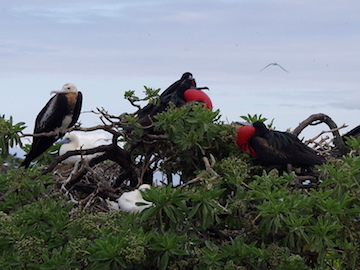420716-Frigate_Birds.jpg

Frigate birds on Eastern Island at Midway Atoll in the Pacific Ocean. Credit: Gary B. Edstrom
Most birds are creatures more of the land or sea than of the air — they spend far more time on the surface than in the sky. But not the frigate bird. It stays aloft for days or weeks at a time. And one species can remain in the sky for up to two months.
Frigate birds are large seabirds found in tropical regions across the globe. The largest of the five species — the magnificent frigate bird ¬¬— can be more than three feet long, with a wingspan of up to seven feet. The birds feed mainly by skimming just above the water and catching small fish that have been chased to the surface by predators.
They almost never alight on the water because they can’t swim. And if they can’t catch anything in the water, they have a nasty habit of chasing other birds until they drop their prey — or throw it up — and then catching their ill-gotten prize in mid-air.
The frigate bird has the highest ratio of wing area to body weight of any bird — and that’s one of the keys to its ability to remain in the air for so long. It doesn’t have to flap its wings much to fly — it catches updrafts that carry it aloft, then glides for hours at a time. It may even take little naps when it’s caught in those updrafts.
Researchers placed satellite trackers on some great frigate birds in the Pacific and Indian oceans. They found that the birds could climb to altitudes of more than 13,000 feet, cover up to 250 miles a day, and remain airborne for up to two months — a lot of air time for a bird that really likes to fly.

